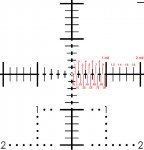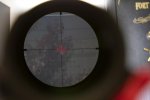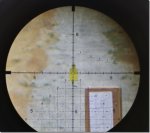Hey guys, I have been fortunate enough to pick up some support from Desert Tech (formerly Desert Tactical Arms) in my competitive shooting. Along with a new A1 rifle chassis came a Kahles K624i optic with Desert Tech's own patented reticle known as the Advanced Milling Reticle or AMR. From the time of its release, lots of reviews and information has come out on the excellent Kahles K624i rifle scope. Having said that, I am going to touch very little on the scope itself and focus on the reticle that DT has developed for the K624i.
The AMR reticle was developed by Nick Young and Russ Wallis of Desert Tech. It's main quality for me is that it has .2 mil sub tensions on both the horizontal and vertical cross hairs instead of .5 mil like most other milliradian based reticles. The center of the cross hair is a modified floating center dot. Instead of a true floating dot, it has 4 hashes that measure .06 mil across. Below the horizontal, the reticle begins to expand by 1 mil both horizontally and vertically and continues all the way to the bottom, which at 6 times magnification is just over 33 milliradians.

This is a schematic of the very center of the reticle.

This picture shows the entire reticle as seen at 24 times magnification. Notice that I am holding over 6 mils (should be 5.7, but I bumped the scope) on a 12" circle at 845 yards.

This picture is the top view if I had dialed in the hold over.
When I shoot comps, if at all possible, I prefer to dial in the elevation and then hold off for the windage. Before I had this scope, I always felt like I was guessing with .5 mil sub tensions. With this reticle having .2, I feel like I am able to hold the same wind much more precisely on every shot. The .2 mil horizontal is my favorite thing about this reticle, and in my opinion, reason enough to make this purchase.
Like I said, if I have the opportunity I will always dial elevation. However, the .2 vertical is very useful to me in competition when you have targets at multiple distances and not a lot of time. I know some people will hold elevation for every shot, this is certainly not for me. I did want to try that out with this reticle for training purposes and just to say that I did it. So, this past weekend, I did just that at our local monthly shoot. I never moved the turret off 0 and shot the entire comp that way. It did work very well, but probably cost me a little placing wise.
I have shown this reticle to lots of tactical comp shooters, and most are pretty impressed by it. I do hear some guys comment on the "Christmas Tree" below and how they are afraid it will hinder their ability to spot misses. The Christmas Tree doesn't start up until one mil below the horizontal. I know that I for one have missed plenty of shots, but usually by less than half a mil and rarely by an entire mil. On that note, I have taken to using the Christmas tree to measure my misses. The dot grid works very well to quickly and accurately measure my miss to the center of the intended target. I will simply spot my miss and then move the reticle to the Christmas tree for a quick and accurate measurement.
Of course, the main reason for this Christmas tree is for extreme long range shooting. My Kahles will adjust 21.2 mils from it's 100 yard zero while sitting in a 30 MOA mount. This will get my 338 Lapua Magnum to about 2100 yards. Anything further that that, you just use the reticle to holdover both wind and elevation.
When ever I read an article, I am always interested in the point of view of the author because I know this will translate directly to my interest in the product. After all, I know my shooting has very little in common with bench rest shooting and I am uninterested in a bench rest shooter's view on equipment. So, a little bit about my shooting if you will. I grew up hunting large game and gradually moved towards faster pace shooting in coyote calling competition. This evolved into long range shooting, and quickly into extreme long range shooting out to about 2150 yards. Then through a friend, I was introduced to tactical long range competition where I became hooked. I have been shooting tactical for about 2.5 years now. In addition to my main focus of tactical, I also shoot 3 gun.
Thanks for reading this review of what I believe comes close to being the perfect tactical scope reticle.
Tyler Frehner
Desert Tech shooter
Sin City Precision

The entire package being shot by my beautiful assistant who is possibly the perfect package.

Another view of the reticle looking at the amazing shooting facility that is K&M Precision.
The AMR reticle was developed by Nick Young and Russ Wallis of Desert Tech. It's main quality for me is that it has .2 mil sub tensions on both the horizontal and vertical cross hairs instead of .5 mil like most other milliradian based reticles. The center of the cross hair is a modified floating center dot. Instead of a true floating dot, it has 4 hashes that measure .06 mil across. Below the horizontal, the reticle begins to expand by 1 mil both horizontally and vertically and continues all the way to the bottom, which at 6 times magnification is just over 33 milliradians.

This is a schematic of the very center of the reticle.

This picture shows the entire reticle as seen at 24 times magnification. Notice that I am holding over 6 mils (should be 5.7, but I bumped the scope) on a 12" circle at 845 yards.

This picture is the top view if I had dialed in the hold over.
When I shoot comps, if at all possible, I prefer to dial in the elevation and then hold off for the windage. Before I had this scope, I always felt like I was guessing with .5 mil sub tensions. With this reticle having .2, I feel like I am able to hold the same wind much more precisely on every shot. The .2 mil horizontal is my favorite thing about this reticle, and in my opinion, reason enough to make this purchase.
Like I said, if I have the opportunity I will always dial elevation. However, the .2 vertical is very useful to me in competition when you have targets at multiple distances and not a lot of time. I know some people will hold elevation for every shot, this is certainly not for me. I did want to try that out with this reticle for training purposes and just to say that I did it. So, this past weekend, I did just that at our local monthly shoot. I never moved the turret off 0 and shot the entire comp that way. It did work very well, but probably cost me a little placing wise.
I have shown this reticle to lots of tactical comp shooters, and most are pretty impressed by it. I do hear some guys comment on the "Christmas Tree" below and how they are afraid it will hinder their ability to spot misses. The Christmas Tree doesn't start up until one mil below the horizontal. I know that I for one have missed plenty of shots, but usually by less than half a mil and rarely by an entire mil. On that note, I have taken to using the Christmas tree to measure my misses. The dot grid works very well to quickly and accurately measure my miss to the center of the intended target. I will simply spot my miss and then move the reticle to the Christmas tree for a quick and accurate measurement.
Of course, the main reason for this Christmas tree is for extreme long range shooting. My Kahles will adjust 21.2 mils from it's 100 yard zero while sitting in a 30 MOA mount. This will get my 338 Lapua Magnum to about 2100 yards. Anything further that that, you just use the reticle to holdover both wind and elevation.
When ever I read an article, I am always interested in the point of view of the author because I know this will translate directly to my interest in the product. After all, I know my shooting has very little in common with bench rest shooting and I am uninterested in a bench rest shooter's view on equipment. So, a little bit about my shooting if you will. I grew up hunting large game and gradually moved towards faster pace shooting in coyote calling competition. This evolved into long range shooting, and quickly into extreme long range shooting out to about 2150 yards. Then through a friend, I was introduced to tactical long range competition where I became hooked. I have been shooting tactical for about 2.5 years now. In addition to my main focus of tactical, I also shoot 3 gun.
Thanks for reading this review of what I believe comes close to being the perfect tactical scope reticle.
Tyler Frehner
Desert Tech shooter
Sin City Precision

The entire package being shot by my beautiful assistant who is possibly the perfect package.

Another view of the reticle looking at the amazing shooting facility that is K&M Precision.








